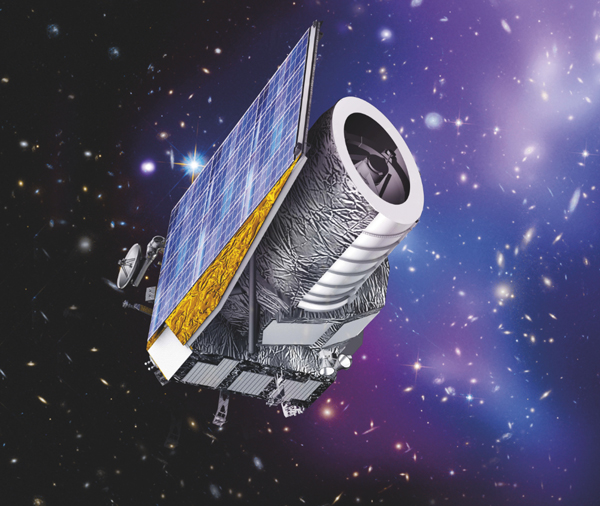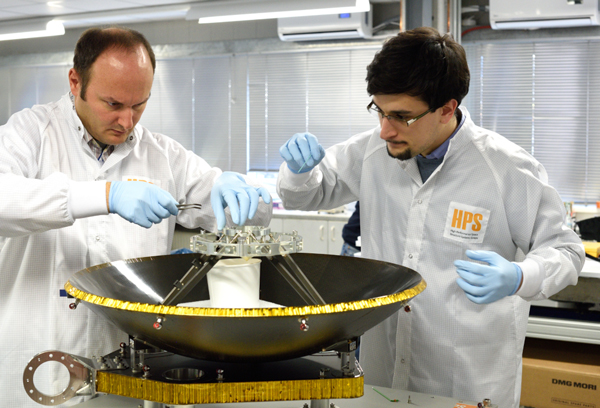December 2017
EUCLID: ESA-Project to Search for Dark Matter and Energy takes Crucial Step
HPS Germany receives STM-acceptance for first model of the central antenna unit
Albert Einstein is supposed to have said that only two things are unlimited: human stupidity and the universe. Concerning the universe, however, he was not sure, because the central power of gravity rather supports the contraction than the expansion of matter. Meanwhile, and based on theoretical models only, scientists are pretty certain that indeed there must be a third and even stronger power than gravity in the universe, counteracting its effects: A dark energy field, making up for 68 percent of all energy in the universe, supporting its unlimited expansion. Even more, it is believed that about 80 percent of matter in the universe consists of something that nobody has seen, yet: Dark Matter, that makes up for 27 percent of energy density in the universe, while Baryonic matter – the stuff that everything is made of that we know – contributes just five percent. Finding out about both is the target of EUCLID, the new space telescope of the European Space Agency ESA.
On June 27th, 2013, ThalesAleniaSpace Italy (TAS-I) has been assigned the task to coordinate the development of the spacecraft which will orbit the sun from 2020 to 2026 at a distance of 1.5 million kilometers from earth in order to 3D-map the Dark Matter of up two billion galaxies.
EUCLID is going to work with two instruments covering the visible and the near infrared domains.
Measurement results and stored telemetrical data will be sent to the ground station through a central adjustable antenna with a diameter of just 70 centimeters using K-Band (26 GHz) to transmit up to a max of 850 GB during four hours per day. The telemetry data are going to be transmitted via X-band; EUCLID itself is also controlled through X-band.
The Spanish subsidiary of ThalesAleniaSpace, TAS-ES, ordered the complete set of design, analysis, manufacturing, integration and testing of the K-band antenna structure assembly at the European antenna-specialist HPS Germany – the company that is highly renowned in Europe and beyond since more than 12 years for successful design and production of ultra-precise antennas for spacecrafts and satellites; absolute reliability of the EUCLID-ARA (Antenna Reflector Assembly) is simply one of the central preconditions for the success of the whole mission – a mission that is run by a consortium of almost 1,000 scientists from 100 institutes and 13 European countries plus even one from the United States. All images from both instruments on board will be transmitted via this one central antenna.


The HPS-design for the EUCLID-antenna is based on a special, highly conductive carbon fibre technology to keep the antenna extremely light, precise and robust in an environment that is characterized by widely changing temperatures at 1.5 million kilometers from earth; the antenna has to keep up reliable service out here for a mission duration of six years.
HPS has executed an detailed test campaign to verify design and technology of the reflector. The antenna proved to withstand thermal cycles and vibration tests, not only keeping the desired accuracy, but in parts even surpassing the specifications required for flawless data transmissions . To make clear what that means in practice: the permissible geometrical production tolerance here is lower than 50 µm, equivalent to the diameter of a human hair, while the acceptable degree of the antenna´s focal pointing tolerance due to temperatures between -45 and +135 degrees centigrade in space is limited up to just ten thousands of one angular degree. To put that also into perspective: this is like observing from earth the deviation of two points which are actually just 70 kilometers away from each other on the moon.
In addition, the extremely good relation of mass (4.5 kg) to rigidity (> 150 Hz Eigenfrequenz) is yet another special and valuable quality of this HPS antenna technology.
Back in May 2017 HPS delivered the first model of the K-band antenna reflector assembly, now in December it received its formal „STM-Acceptance“. Two more models follow in 2018, one of them will be the original one for the mission flight.
HPS is one of the few companies in Europe able to develop and deliver highly precise antenna reflectors. Among others, currently a reflector with 2.4 meters diameter (Q/V-band) is in production, while the qualification model of another Ka-band antenna for the German Heinrich Hertz-mission just has been successfully tested. The company´s portfolio ranges from 0.5 to 2.5-meter reflector antennas as well as for large deployable antennas from 5 to 20 meters. With this special knowhow HPS safeguards Germany´s position in the world´s top league of space antenna specialists.
